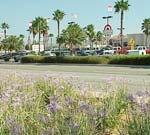Water Resources Management
Located in an arid region of western Riverside County in America’s great desert southwest, EMWD and its customers rely heavily on water imported hundreds of miles from the Colorado River and from northern California. While desert areas like ours are not all void of significant underground aquifers that can sustain large populations, the area served by Eastern boasts only enough groundwater to meet a small portion of its needs.
EMWD continues efforts to develop local resources, such as groundwater and desalination, as well as to conserve resources by expanding recycled water use. Nevertheless, up to 75% of the service area’s drinking water must still be imported from The Metropolitan Water District of Southern California (MWD), of which EMWD is one of 26 member agencies.
To learn more about the commercial landscaping and water budget provisions, send email to: conservation@emwd.org.
With population in the 555 gross square mile service area at about 785,000, EMWD needs to stretch available water supplies. The district’s conservation program is one tool it uses to accomplish the task of making every drop of water go further.
Most Californians remember the drought of the late 1980s-early 1990s. But rather than being the exception, periods of drought have historically been normal in California. There is no reason to believe the future will be any different. The California climate goes through periods of unusually high rain and snowfall, and through periods of extremely little precipitation. Those extremes are the norm; truly “normal” years in terms of precipitation are rare. In general, the areas served by EMWD receives 10 to 12 inches of rainfall per year – that’s less rain than in tombstone, Arizona!
Despite all this, sufficient precipitation generally falls on California to meet the state’s needs in terms of quantity, but it is usually not distributed well to meet 21st century society’s needs. Roughly two-thirds of the precipitation falls in the northern part of the state, while about two-thirds of the population and the water demand are in the southern part. Regulatory restrictions complicate matters by limiting the amount of water than can be delivered from northern California.
The District’s conservation programs have a significant impact on water use throughout the region. Typical customers today are using less water than they did in the past, and that means a slower increase in demand placed on the distribution system of EMWD and its neighboring water agencies. That, in turn, means lower construction and system maintenance costs and less water imported from outside sources. Ultimately, customers are able to get the water they need at the best possible rates.


